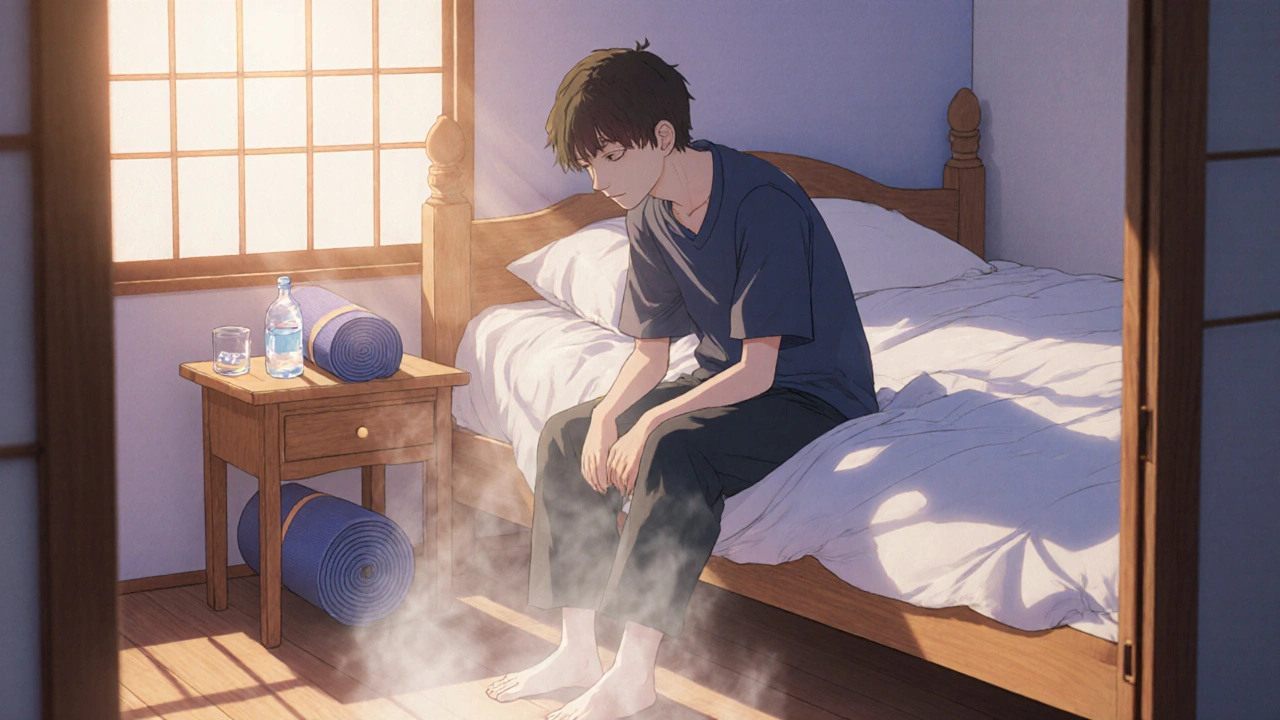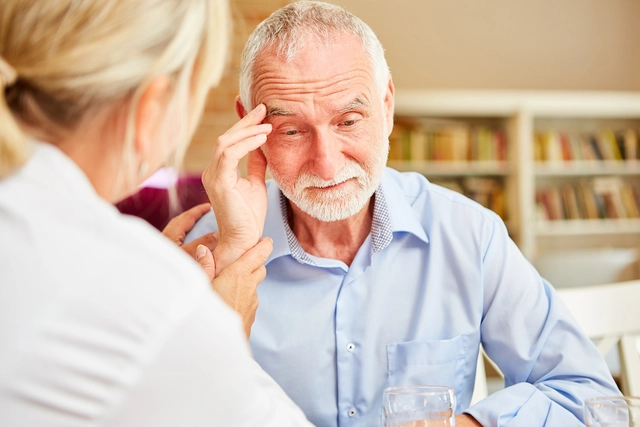
IOH & Chronic Pain Symptom Checker
This tool helps you assess your symptoms related to orthostatic hypotension (dizziness when standing) and chronic pain. It's not a diagnosis but can help determine if you should seek medical evaluation.
Orthostatic Hypotension Symptoms
Chronic Pain Symptoms
When you feel dizzy every time you stand up and also battle persistent aches, the connection might not be a coincidence. Recent research shows a surprising overlap between Idiopathic Orthostatic Hypotension and Chronic Pain. Understanding how these two seemingly unrelated conditions interact can unlock better diagnosis and relief for patients who suffer from both.
What Is Idiopathic Orthostatic Hypotension?
Idiopathic Orthostatic Hypotension (IOH) describes a drop of at least 20 mmHg systolic or 10 mmHg diastolic blood pressure within three minutes of standing, without an identifiable cause such as medication, dehydration, or neurodegenerative disease. The term "idiopathic" signals that the underlying mechanism remains unclear, making it a diagnostic challenge.
Key features include sudden light‑headedness, visual blurring, and in severe cases, syncope. Patients often report difficulty completing routine tasks that require standing - from getting out of bed to shopping trips.
Chronic Pain: A Quick Overview
Chronic pain persists for more than three months and can stem from injuries, inflammatory conditions, or nerve dysfunction. Unlike acute pain, which serves as a warning signal, chronic pain becomes a disease in its own right, altering brain pathways and stress hormones.
Common forms include low‑back pain, fibromyalgia, neuropathic pain, and migraine. The condition heavily impacts quality of life, mood, and sleep, creating a vicious cycle that amplifies both physical and psychological distress.
Shared Autonomic Pathways
Both IOH and chronic pain involve the autonomic nervous system (ANS). The ANS regulates blood vessel tone, heart rate, and sweat production, while also modulating nociceptive (pain) signals.
Studies reveal that reduced sympathetic baroreflex sensitivity - the body's ability to quickly correct blood pressure drops - often co‑exists with heightened central sensitization, a hallmark of chronic pain. In simple terms, the same nervous system that fails to keep blood pressure steady may also amplify pain signals.
Vascular Regulation and Norepinephrine
Vascular tone is largely controlled by norepinephrine released from sympathetic nerve endings. In IOH, insufficient norepinephrine release or receptor desensitization leads to inadequate vasoconstriction when standing.
Chronic pain patients frequently show dysregulated norepinephrine levels, affecting both pain modulation and mood. Low norepinephrine can blunt the descending inhibitory pathways that normally dampen pain, while high levels may trigger anxiety‑related hypervigilance.

Clinical Evidence Linking the Two
A 2023 observational study of 312 patients with unexplained dizziness found that 38 % also met criteria for chronic widespread pain. Conversely, a cohort of 210 fibromyalgia patients reported orthostatic symptoms in 24 % of cases, suggesting a bidirectional relationship.
Functional MRI scans have highlighted overlapping brain regions - especially the insular cortex and anterior cingulate - that process both blood pressure changes and pain perception. This neuro‑imaging overlap supports the theory of a shared central mechanism.
Diagnostic Approach: Putting the Pieces Together
When faced with a patient who complains of both dizziness on standing and persistent pain, clinicians should follow a systematic work‑up:
- Measure supine and standing blood pressure after 5 minutes seated and after 3 minutes standing.
- Use the Tilt‑Table Test to confirm orthostatic drops and assess heart rate response.
- Screen for chronic pain syndromes with validated questionnaires such as the Brief Pain Inventory or the Fibromyalgia Impact Questionnaire.
- Order basic labs (CBC, metabolic panel, thyroid function) to rule out secondary causes.
- Consider autonomic testing - heart rate variability, sweat‑spot testing, and catecholamine levels - especially if symptoms are severe.
Identifying co‑existing conditions early enables targeted therapy rather than treating each complaint in isolation.
Management Strategies That Address Both Conditions
Therapeutic plans should aim at improving vascular tone while simultaneously dampening central pain sensitization.
- Volume Expansion: Increasing fluid intake (2‑3 L/day) and adding salt (up to 3 g/day) can boost intravascular volume, helping stabilize blood pressure.
- Pharmacologic Options:
- Fludrocortisone (0.1 mg daily) promotes sodium retention.
- Midodrine (5‑10 mg TID) acts as an alpha‑agonist to constrict vessels.
- Low‑dose beta‑blockers may improve baroreflex sensitivity in certain patients, though they must be used cautiously.
- Neuromodulators for Pain: Agents such as duloxetine (an SNRI) raise norepinephrine and serotonin, simultaneously improving mood, pain thresholds, and sometimes orthostatic tolerance.
- Physical Counter‑maneuvers: Leg crossing, calf muscle tensing, and abdominal compression before standing can temporarily raise venous return.
- Exercise Therapy: Graded aerobic programs improve vascular conditioning and release endogenous opioids that reduce pain.
- Compression Garments: Thigh‑high stockings (30‑40 mmHg) limit blood pooling in the legs.
Individualizing the regimen based on symptom severity, comorbidities, and tolerance yields the best outcomes.

Lifestyle Tweaks and Self‑Management
Simple daily habits often make a big difference:
- Rise slowly: Sit for a minute, then stand, while performing a quick calf raise.
- Stay hydrated: Carry a reusable bottle and sip regularly.
- Limit alcohol and large meals, which can aggravate both blood pressure drops and pain flares.
- Prioritize sleep: Poor sleep heightens pain sensitivity and impairs autonomic regulation.
- Mind‑body techniques: Guided breathing, progressive muscle relaxation, and mindfulness have been shown to attenuate sympathetic overactivity.
Future Directions: Research and Emerging Therapies
Scientists are exploring genetic markers that predispose individuals to autonomic failure, such as mutations in the Norepinephrine Transporter (NET) gene. Early identification could allow pre‑emptive lifestyle counseling.
Novel agents like selective serotonin‑norepinephrine reuptake inhibitors (SNRIs) with minimal cardiovascular side effects are in Phase II trials for combined orthostatic and pain syndromes.
Wearable technology that continuously monitors blood pressure and heart rate variability promises real‑time alerts, helping patients avoid fainting episodes while tracking pain‑related autonomic spikes.
Key Takeaways
- Idiopathic orthostatic hypotension and chronic pain share autonomic dysregulation as a core mechanism.
- Comprehensive assessment should include orthostatic vitals, pain questionnaires, and autonomic testing.
- Management that combines volume expansion, targeted medications, exercise, and neuromodulators can improve both blood pressure stability and pain levels.
- Lifestyle adjustments and emerging wearable tech offer practical support for daily living.
Frequently Asked Questions
Can orthostatic hypotension cause chronic pain?
Yes, reduced blood flow to the brain and spinal cord during standing can trigger nociceptive pathways, especially in people with pre‑existing sensitization. The chronic lack of proper perfusion may also worsen muscle fatigue, contributing to pain.
Is it safe to use midodrine if I already take pain medication?
Midodrine can be combined with many analgesics, but caution is needed with drugs that raise blood pressure (e.g., certain NSAIDs) or depress central nervous system function. Always discuss dosage adjustments with a physician.
What non‑drug options help both conditions?
Gradual aerobic exercise, compression stockings, and physical counter‑maneuvers improve vascular tone, while mindfulness, yoga, and structured sleep hygiene lower pain perception and support autonomic balance.
How long does it take to see improvement after starting treatment?
Patients often notice reduced dizziness within 1‑2 weeks of volume expansion or medication titration. Pain relief may take 3‑6 weeks, especially when using neuromodulators that need time to adjust neurotransmitter levels.
Are there any red‑flag symptoms that require emergency care?
Sudden loss of consciousness, chest pain, shortness of breath, or a rapid heart rate (>120 bpm) while standing should prompt immediate medical attention.
By recognizing the intertwined nature of idiopathic orthostatic hypotension and chronic pain, clinicians and patients can move beyond treating symptoms in isolation and aim for a more holistic, lasting relief.
8 Comments
Write a comment
More Articles

Buy Cheap Generic Seroquel Online - Safe Guide 2025
Learn how to purchase cheap generic Seroquel safely online. Get price comparisons, buying steps, red‑flag warnings and tips for quality online pharmacies in 2025.

The Role of Psychological Counseling in Dementia of the Alzheimer's Type Care
In my latest blog post, I discuss the vital role psychological counseling plays in the care of individuals with Alzheimer's-type dementia. I highlight how counseling not only supports patients in coping with the emotional and cognitive challenges of the disease but also provides essential guidance to their caregivers. Furthermore, I emphasize the importance of early intervention to maximize the benefits of counseling. Through my research, I've discovered that psychological counseling can significantly improve the overall quality of life for both patients and their families. So, let's spread awareness about the invaluable support that counseling can offer in Alzheimer's care.

Safer Alternatives to Warfarin: New Anticoagulant Options and Bleeding Risk Data
Curious if there’s something safer than warfarin for blood thinning? This article explores the latest research on bleeding risks and antidotes for the new class of anticoagulants. You’ll see clear comparisons, practical tips, and what to look for if you or a loved one may need a switch. Want peace of mind about managing your blood thinner? Read on for real-world data, not just theory. We even dig into alternatives and how to talk to your doctor about making the change.

ashanti barrett
October 19, 2025 AT 21:26I've seen a lot of patients who complain of feeling light‑headed right after they stand up, and they also mention a constant ache in their lower back or neck. The overlap isn’t random – both conditions tap into the autonomic nervous system, which can get a bit sloppy when you’re dehydrated or have an underlying dysregulation. When the baroreflex can’t keep blood pressure steady, the same neural pathways that modulate pain can become hyper‑active. That's why a simple tilt‑table test can sometimes reveal both the drop in pressure and an exaggerated pain response. Keeping an eye on norepinephrine levels and making sure fluid intake is adequate can help dock those two symptoms together.